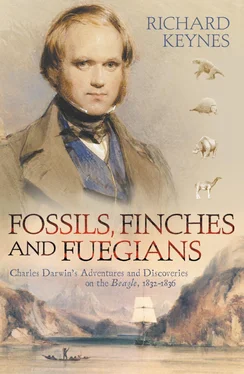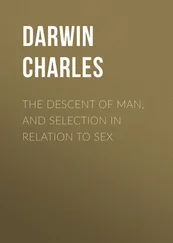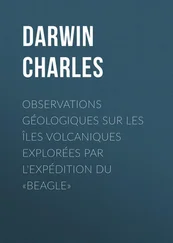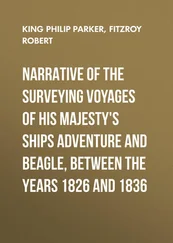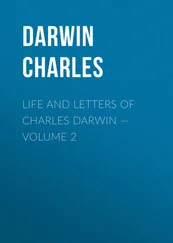
Charles’s occasional lapses into French in his notes were the consequence of his dependence on books by the encyclopédistes Cuvier, Lamarck, Lamouroux and others in the Beagle ’s library, his favourite being the seventeen volumes of the Dictionnaire classique d’histoire naturelle , edited by Jean Baptiste Genevieve Marcellin Bory de Saint-Vincent.
Although spiders are important insect predators, Charles found that sometimes the tables were turned, for he came upon wasps known as mud daubers of the family Sphecidae that hunt spiders as food for their larvae. He wrote:
I have frequently observed these insects carrying dead spiders, even the powerful genus Mygalus, & have found the clay cells made for their larvæ, filled with dying & dead small spiders: to day (June 2 d) I watched a contest between one of them & a large Lycosa. The insect dashed against the spider & then flew away; it had evidently mortially [ sic ] wounded its enemy with its sting; for the spider crawled a little way & then rolled down the hill & scrambled into a tuft of grass. The Hymenoptera [wasp] most assuredly again found out the spider by the power of smell; regularly making small circuits (like a dog) & rapidly vibrating its wings & antennæ: It was a most curious spectacle: the Spider had yet some life, & the Hymenop was most cautious to keep clear of the jaws; at last being stung twice more on under side of the thorax it became motionless. The hymenop. apparently ascertained this by repeatedly putting its head close to the spider, & then dragged away the heavy Lycosa with its mandibles. I then took them both. 65
‘Whilst on board the Beagle,’ wrote Charles in his Autobiography , ‘I was quite orthodox, and I remember being heartily laughed at by several of the officers (though themselves orthodox) for quoting the Bible as an unanswerable authority on some point of morality.’ So at this time he had not yet begun to think seriously about the manner in which new species of animals might come into being, and his orthodoxy included a belief in a world tenanted by constant species that had originated at specific centres of creation. Since he was well-versed by now in the first two volumes of Charles Lyell’s Principles of Geology , this does not of course mean that he subscribed to the absolute truth of the first book of Genesis, nor to the accuracy of Bishop Usher’s calculations of the age of the earth. But he had been impressed at Cambridge by William Paley’s argument in his Natural Theology that in looking at the living world ‘The marks of design are too strong to be gotten over. Design must have had a designer. That designer must have been a person. That person is God.’ In due course his faith in Paley waned, but as will be seen he continued to speak of a Creator in his notes until 1836, so that specifically on the evolutionary front his thoughts had not yet moved far when he was in Brazil.
All the same, he had already made significant advances in two important biological fields of which he was one of the founding fathers. Thus from the very beginning of the voyage he regarded the behaviour of the animals he observed as equal in importance to the anatomical differences between them in distinguishing between species. A good example was provided by his comments on the butterfly Papilio feronia :
This insect is not uncommon & generally frequents the Orange groves; it is remarkable in several respects. It flies high & continually settles on the trunks of trees; invariably with its head downwards & with its wings expanded or opened to beyond the horizontal plane. It is the only butterfly I ever saw make use of its legs in running, this one will avoid being caught by shuffling to one side. Some time ago I saw several pairs, I presume males & females, of butterflies chasing each other, & which from appearance & habits were I am sure the same species as this. Strange as it may sound, they when fluttering about emitted a noise somewhat similar to cocking a small pistol; a sort of a click. I observed it repeatedly. June 28 th. In same place I observed one of these butterflies resting as described on a trunk of tree; another happening to fly past, immediately they chased each other, emitting (& there could be no mistake the space being open) the peculiar noise: this is continued for some time & is more like a small toothed wheel passing under a spring pawl. – The noise would be heard about 20 yards distant. This fact would appear to be new. 66
A preliminary examination of a specimen of the butterfly in 1837 by G.R. Waterhouse at the London Zoological Society provided no explanation for the source of the peculiar noise, but a few years later it was found by another entomologist that it was produced by a sort of drum at the base of the fore wings, together with a screw-like diaphragm in the interior.
Another important branch of biology in which Charles was a leading pioneer, along with Linnaeus, Buffon and Humboldt, is the study of mutual relations between animals and their environment, for which the term ‘ecology’ was introduced in 1873. Here too, Charles’s basically new way of thinking was apparent from the first in his notes. Summarising his general observations on what he had seen in Rio, he wrote:
I could not help noticing how exactly the animals & plants in each region are adapted to each other. Every one must have noticed how Lettuces & Cabbages suffer from the attacks of Caterpillars & Snails. But when transplanted here in a foreign clime, the leaves remain as entire as if they contained poison. Nature, when she formed these animals & these plants, knew they must reside together.
Referring to collections of insects he had made on the shore behind the Sugar Loaf in Rio, he said that since the situation was much the same as that of Barmouth when he was collecting there in August 1828, many of the species would be closely allied. On another occasion he wrote:
In my geological notes I have mentioned the lagoons on the coast which contain either salt or fresh water. The Lagoa near the Botanic Garden is one of this class. The water is not so salt as the sea, for only once in the year a passage is cut for sake of the fishes. The beach is composed of large grains of quartz & very clean. If cemented into a breccia or sandstone it would precisely resemble a rock at Bahia containing marine shells. A small Turbo [a turban snail] appeared the only proper inhabitant, & thus differed from the lagoons on the Northern coast in the absence of those large bodies of Bivalves. I was surprised on the borders to see a few Hydrophili [water beetles] inhabiting this salt water, & some Dolimedes [a nursery web spider] running on the surface.
CHAPTER 7
An Unquiet Trip from Monte Video to Buenos Aires
At nine o’clock in the morning on 5 July the Beagle sailed out of the harbour at Rio on a gentle breeze, hailed by a salute of hearty cheers from the crews of HMS Warspite and HMS Samarang . FitzRoy noted with some satisfaction that ‘Strict etiquette might have been offended at such a compliment to a little ten-gun brig, or indeed to any vessel unless she were going out to meet an enemy, or were returning into port victorious: but although not about to encounter a foe, our lonely vessel was going to undertake a task laborious, and often dangerous, to the zealous execution of which the encouragement of our brother-seamen was no trifling enducement.’
For the next three weeks the Beagle sailed on to the south, sometimes in light winds when progress was disappointingly slow, sometimes in gales when even the sight of a whale possessed little interest to Charles’s jaundiced eyes, but best when the studding sails were ‘alow & aloft – that is wind abaft the beam & favourable’. On the morning of 14 July Charles noted:
Читать дальше
